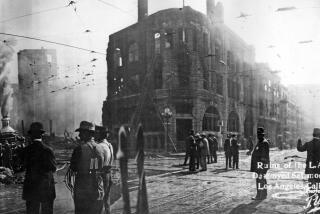Historian Reignites Gunpowder Plot : FAITH AND TREASON, The Story of the Gunpowder Plot by Antonia Fraser Nan A. Talese / Doubleday $27.95, 347 pages
- Share via
“The proposition put by Catesby was simple and it was bloodcurdling. A scheme would be devised to blow up ‘the Parliament House with gunpowder’ in order to destroy the king and his existing government.”
It was Sunday, May 20, 1604--five energetic, young, Catholic men sitting around a table at the Duck and Drake, flushed with ale and ardor--but it could have been yesterday. Or tomorrow. The British have long memories, an unblunted sense of history.
In Dublin’s pubs of a rainy evening, they still sing the health of “The Fenian Men of ‘98” (1798), Glaswegians glower at the royal “ER II” insignia on their mailboxes and change the II to I (they still don’t recognize the first Elizabeth in Scotland). In Northern Ireland, Protestants march each July to celebrate the Battle of the Boyne, when Protestant King William III defeated the army of Catholic James II in 1690.
Whipping the flames with her own deft and distinctive fan is Antonia Fraser, ad hoc historian of England, chronicler of kings and queens, whose considerable reputation is in no danger here. Fraser pumps plasma into the old questions, poses a few new ones, takes sides sparingly and slyly. (Descended from a noble Catholic line, the author is careful to condemn terrorism of any sort, but occasionally hedges on the ends / means dilemma.)
Who were the real plotters? Indeed, was there a plot at all, or, as isolated dissenters yet maintain, was the whole affair a put-up job, a Protestant smoke screen, a ruse akin to the Reichstag fire?
What drove the young men to such desperate measures? Who betrayed whom? How much did Parliament pay the ironsmith who forged the rods upon which the severed heads of the plotters were spiked for public display? (This last is a typical and endearing Fraser footnote; answer: 23 shilling and ninepence.)
Setting the scene for those of shorter memory: The doughty, long-lived Elizabeth has died, childless. Parliament has chosen James VI, king of Scotland, as successor--a somewhat distant relative and a relatively popular choice, he being a man and all. Above all, James (to be James I of England) is a Protestant, an overwhelming consideration in an age when politics and religion are inseparable.
It is, of course, more complicated. Elizabeth was daughter of Anne Boleyn and Henry VIII, who single-handedly declared his kingdom Protestant when the pope of the day refused to legitimize Henry’s divorce. James is the son of Mary, Queen of Scots, a Catholic beheaded by Elizabeth. James is married to the beauteous and fecund Anne of Denmark, a closet Catholic. So just how Protestant is the king?
It is a question of paramount importance, literally a matter of life and death. The lot of England’s declared Catholics is sore and sorry. An officially despised minority, they are forbidden by law to practice their religion. They are barred from any jobs worth holding. They are fined to ruination. They are tortured. Jesuits’ “mere presence in England” is illegal and punishable by execution.
James is nothing, if not a consummate politician. Before his coronation, he promises everything to everybody, especially the Catholics. And once in power, he reneges.
So the angry young men, despairing of changing the system peacefully, resolve to blow up Parliament and the king. They are led by the charismatic but hotheaded Robert (Robin) Catesby, abetted by the brothers Wright, cousin Francis Tresham, Sir Everard Digby, Thomas Percy and Guy Fawkes.
Fawkes is the fall guy. “The outsider in the band,” writes Fraser, Fawkes was nevertheless sturdy, dedicated, probably the bravest of the lot--resisting unconscionable torture long enough to enable his mates to flee. Before joining the plot, he was a mercenary soldier in Flanders (to avoid the oath to the queen), only to be caught in the cellar under the House of Lords with 36 barrels of gunpowder. (Though Catesby was indisputably the mastermind, it is Fawkes’ name that somewhat inexplicably tags the yearly Saturnalia, rather like celebrating an annual Watergate Burglars Night.)
Fraser keeps alive character and moral conundrum with skill, dealing with history as it should be dealt with--as both legacy and lesson. As the kids still chant on Guy Fawkes Day, “Please to remember the Fifth of November / Gunpowder Treason and Plot. / We know no reason why Gunpowder Treason / Should ever be forgot.”
More to Read
Sign up for our Book Club newsletter
Get the latest news, events and more from the Los Angeles Times Book Club, and help us get L.A. reading and talking.
You may occasionally receive promotional content from the Los Angeles Times.








